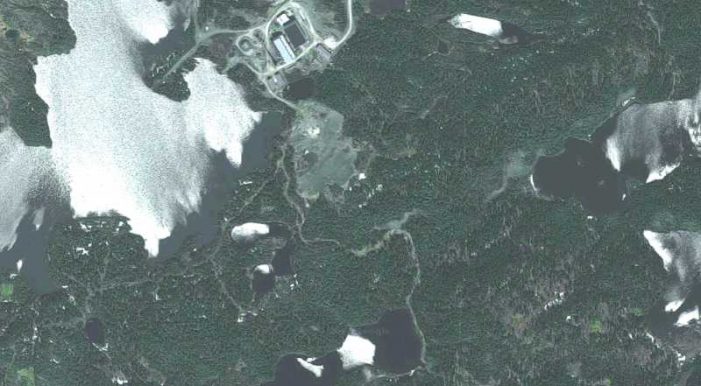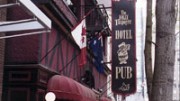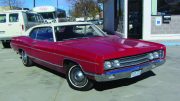The excitement of a mineral discovery is a “Eureka!” moment, and this is the story of my three Eureka moments. I’m 77 years old now, so some of the details may be misted by time, but the big picture is correct.
For the first six years of my life I lived in Copper Cliff in Ontario where my dad worked for Inco in the smelter. In 1946 we moved to Joeburke, Ont., which was a whistle stop along the CNR main line between Gogama and Foleyet.
The developing Joeburke Gold Mines gold mine was a mile or so into the bush from the rail line, and my family moved to the area to be part of the developing gold mining community. It didn’t work out that way, but that’s another story.
My dad and mom ran a grocery store and post office near the railroad and had a few tents stretched over two-by-fours and plywood frames which they rented to miners and their families.
Our horse Nellie was a feisty black mare that pulled us around winter and summer to deliver groceries and light freight.
My first two trips down a mine was when I was 7 years old, where I learned what gold looked like. I really enjoyed those trips, liked the feel of the underground and made a career decision that I wanted to be in this business — and have now been in it for more than 50 years.
It was not always easy, but I’m happy I made that decision and wouldn’t change it.
Now onto my first Eureka moment.
Joe Brummer hired me in November 1962 to work for him on a nickel exploration project with headquarters in Wabowden, Manitoba. It was my first real job in mining and a formative experience. I was to look after expediting, core management, sampling and X-ray analysis using a Philips portable X-ray spectrometer. Some of the other members of the exploration team during that winter drilling program were Colin Coates, Bill Dales, Dave Emery, Max Good, Roy Saukko and Pete Potapoff. At one point of the winter program we had 15 drills operating.
With a diamond-impregnated grinding wheel, the operator Alf Baer would grind a uniform groove along the sample length of the core and give me the grindings in a paper sample bag for nickel and copper analysis in the X-ray spectrometer. It was a new tool at that time and good for quickly determining the grades of the metals in core samples without sending samples to a lab for expensive analysis, the results of which would be received several weeks later.
One morning in March 1963 Max Good was planning to fly out to check on the progress of one of the drills he was overseeing at an anomaly being tested. I got an early morning start and ran assays on the core he had recovered to date on that anomaly and “Eureka!” we had some 6%+ nickel assays.
I saw Max going towards the airbase to get the plane and called him over to my workplace to see the results. We took the results to Joe, who was pleased.
There was excitement in the air — we had a discovery!
This discovery eventually became the Manibridge Mines orebody. In the summer of 1970 I was employed as a mining engineering student to work there, and was allowed to supervise the change over from shaft sinking to development and do the mine scheduling and preliminary mine layout for production.
The mine was operated by Falconbridge Nickel Mine Ltd (now Xstrata) between 1971 and 1977. The mine had a mineral inventory of 1.41 million tons (including 15% dilution) at 2.25% nickel, 0.27% copper plus cobalt to a depth of 1,250 feet.
Newfoundland zinc
Charlie Pegg, the exploration manager for Leitch Gold Mines, had an idea that there might be a geological environment on the Great Northern Peninsula in Newfoundland similar to that which hosted the lead-zinc mines in Ireland.
A syndicate of three equal partners — Leitch Gold Mines, Highland Bell Silver Mines and American Metals Climax — formed what became Newfoundland Zinc Mines as the operating entity.
In the spring of 1963 Pegg started regional geochem soil & stream bed sediment sampling and prospecting programs in the area around Daniel’s Harbour.
One summer day at noon, Mike Labchuck, a prospector, stopped on the shore of a large pond for lunch. After lunch he smoked a cigarette and like most experienced prospectors butted his cigarette in the ground to be sure it was out.
When he looked at the place where he was butting it, the rock was cauliform honey jack sphalerite. Hunting around a bit further, the entire outcrop where he had stopped was the same. He had a discovery. Eureka!
He ran most of the five miles through the bush and swamp back to the coastal road and sped to Angus Wentzel’s motel at Portland Creek where the crew was staying only to find no one there. He had to wait till early evening when the rest of the crew returned from the field to share his excitement. A rum or two was splashed over the lips that evening.
After fruitless geophysical work, drilling started in early 1964 and continued to the end of 1965. Ivor Watson was the geologist in charge of the project for two years and then he moved on in 1966, leaving a solid technical base of 50,000 feet of core and core logs from which to go forward.
Charlie hired me four days after my graduation from the Haileybury School of Mines in May 1966, and during the exploration seasons of 1966 and 1967 we drilled 52,000 feet of X-ray core.
My second Eureka moment occurred in September of 1967 when we intersected 111 feet (true width) of 11.7% zinc on the L Zone, which was the largest orebody there.
This hole was a lucky hit. At that time, we were near the end of our budget and just completing a season-ending final drill hole. I directed Jim Decker, our drill foreman, where to spot the next one. He went to move the drill to the desired location but lo and behold there was a large brush pile in the way, so we moved the hole about 50 feet to save time, work and money.
Presto, with great scientific accuracy we intersected the thickest part of the orebody!
Newfoundland Zinc Mines was acquired by Teck Corporation around 1970-71, and Teck started production at 1,500 tons per day in 1975.
When production ended in 1990 the mine had produced about 7 million tons of zinc ore at an average grade of 7.8% zinc – more or less a billion pounds of zinc.
Nugget Pond
I was president, CEO and controlling shareholder of Bitech Energy Resources Ltd. when, in the spring of 1988, Derek McBride, our consulting geologist, called me from the field to say he had come across an area near Betts Cove, Newfoundland, that seemed to match a geological theory he had about gold deposition.
The area was open for staking and we staked 64 claims.
A few weeks later, Greg Ovens, another geologist on the team, was panning at the inlet of a small creek draining into a pond. He recovered some beautiful gold flakes that still had crystal markings on them. They hadn’t migrated very far.
He named the pond “Nugget Pond”. There was a covered, boggy area with cedar and spruce trees about 75 feet from the creek.
Follow up geophysics & trenching uncovered a 500-foot long and up to 23-foot wide gossan zone.
A soil sample assayed 0.44 oz. gold per ton while grab samples from a trench across the zone assayed up to 2.5 oz. gold per ton. Additional channel sampling in the trench returned 0.45 oz. gold over 23 feet.
By summer’s end we had outlined a gold-bearing zone and drilling was the next step.
We raised $1.5 million from Alex McDonald’s flow-through fund in Vancouver and started a seven-hole drilling program in the fall of 1988.

Gold ore sample from the Nugget pond gold mine in Newfoundland.
The first holes under the trenches returned encouraging results of 8.5 feet grading 1.66 oz gold and 6.6 feet grading 0.71 oz. gold per ton. It was my third Eureka moment.
In early 1989 we entered an option agreement to form a joint venture with Equity Silver to continue the exploration and development of the discovery.
Equity decided not to continue with the program after completion of the initial drilling. The orebody was a bit small for them.
In the spring of 1991 we optioned the property to National Minerals Corporation whereby it would make option payments of $600,000 and spend $5.2 million in exploration and production financing.
The Bitech estimated reserves were 499,000 tons averaging 0.37 oz. gold per ton. National Minerals Corporation was related to Noveder.
In May 1995, Richmont Mines acquired from Noveder a 60% interest in the Nugget Pond gold project, then the remaining 40% in January 1996.
At the end of 1995, the reserves at Nugget Pond totaled 430,000 tonnes at a grade of 10.5 grams gold per tonne.
Richmont began commercial production at Nugget Pond in April 1997, and produced a total of 168,748 oz. gold at low cash costs, and depleted its reserves by 2001.
The mine’s acquisition, development and construction represented an investment of $27 million.

James Wade
— James Wade resides in Asuncion, Paraguay, where consults in mining and oil & gas. (jamesgwade@gmail.com). He looks forward to one more “Eureka!” moment.
The author extends a big “thank you” to George Agelopoulos at The Northern Miner for providing archived articles containing details about Nugget Pond. They were invaluable for this essay.
[Editor-in-chief’s note: readers are welcome to submit their own “Odds ‘n’ Sods” column for publication consideration to tnm@northernminer.com. A Northern Miner Odds ‘n’ Sods column typically recounts a funny, whimsical, poignant or historically significant story from bygone days in a professional’s mining career.]




Be the first to comment on "Odds ‘n’ Sods: My three ‘Eureka!’ moments as a Canadian explorer"